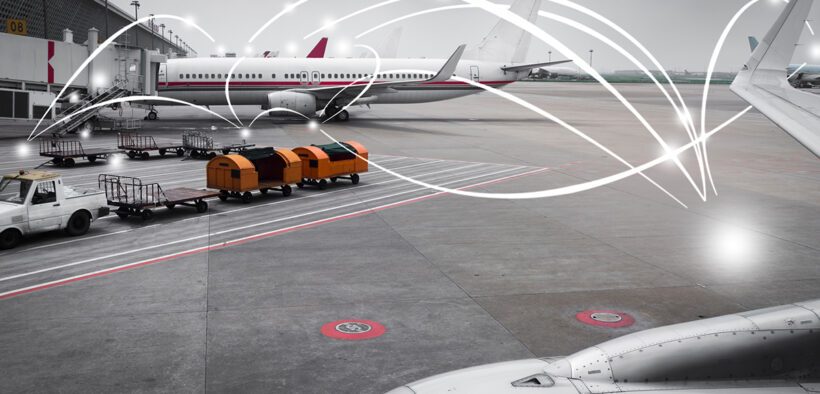Cleared for Takeoff: Private Networks in Aviation
Share

Walking into an airport is often like stepping into an indoor city—complete with retail shopping, restaurants, and thousands of people. Add to that long security lines, baggage tracking, crowded terminals, security personnel, and systems, and airplanes on the tarmac, and the result is an incredibly demanding and complex environment for deploying reliable wireless connectivity. When networks are designed and deployed correctly, no one even notices them. On the other hand, large and expensive issues quickly arise when networks are poorly designed and deployed.
There are many stories across the industry of unreliable connectivity in airport environments that quickly escalate into expensive problems to troubleshoot and fix.
One typical example—familiar to many travelers—is baggage tracking. Most airlines and airports use RFID tracking to manage baggage, the success of these systems largely relies on the wireless connectivity they depend on.
However, when you look deeper into what those technologies are, you find a mix of Wi-Fi networks and public cellular networks, both of which can very often have dead spots when baggage goes below the main levels or onto the tarmac.

The consequences? Lost luggage, delayed flights, and potentially millions of dollars in losses.
Baggage tracking is just one of many examples of critical applications in today’s airports that depend on reliable connectivity.
Designing and deploying reliable networks, though, isn’t a simple task. It requires intention, precision, and the right tools to accurately simulate and test how a network will perform given the various use cases it needs to support before any deployment is done. Without this level of planning, connectivity issues can arise past deployment, becoming far more complex and expensive to resolve.
Why Aviation Needs Purposeful Network Design
Airports are massive, multifaceted ecosystems with unique connectivity needs that sprawl inside and outside the airport. For various reasons, almost every corner of an airport needs to stay connected.
- Passenger Services: Reliable high-speed internet for passengers in terminals and gates.
- Operations: Seamless communication among airport staff, ground crews, and control centers.
- Safety and Security: Dependable networks for critical systems like surveillance cameras, access controls, and emergency communication.
- Logistics: Efficient cargo and baggage handling systems relying on IoT devices.
But designing wireless networks to handle this complexity is more than just deploying network infrastructure. Networks need to be designed holistically, considering existing RF (radio frequency) coverage, technology, compatibility, physical space limits, and scalability for future use cases.
RF Coverage and Technology Interoperability
The complexity of airports presents unique RF design challenges. Large open spaces? Check. Thick walls and structural materials? Check. Competing signals from thousands of devices and equipment? Check and check.
Designing networks that overcome these challenges means considering the following:
- Indoor Coverage: Ensuring reliable connectivity in terminals, baggage handling areas, lounges, and anywhere passengers or operations are located.
- Outdoor Coverage: Supporting runways, tarmacs, and apron areas where ground staff, security, and vehicles operate.
- Seamless Transition: Ensuring passengers, staff, and equipment do not lose connectivity while moving between indoor/outdoor areas or between zones in an airport.

The other consideration within airports (and many other enterprise venues today) is the multiple technologies that exist to support the various use cases around an airport. There’s Wi-Fi to support passengers, public cellular for roaming travelers, public cellular for operational personnel and equipment, private cellular for mission-critical applications, macro networks for coverage on the plane and tarmac—and the list can go on.
Designing the wireless network in an environment where all these technologies are at play means considering what each technology is supporting and how they can all play nicely together. So, being able to have a single source of ‘wireless truth’ to design and then store historical as-built documentation and reports about the environment will offer large benefits not only in the present but also in the future when you go to scale up your deployments.
Scaling Up Deployments
When looking at how private networks are being deployed across the aviation industry, the process often begins with a single use case or pain point to be solved.
For example, a private LTE network might be deployed to support baggage handling automation. While this addresses an immediate operational need, airport connectivity needs are constantly evolving, so the networks that support them will also need to evolve.
Effective network planning considers how the same network and infrastructure can later support additional mission-critical applications that drive additional automation, safety, and passenger use cases within an airport.
How iBwave is Transforming Network Design in Aviation
iBwave provides powerful network survey and design software that enables the industry to accurately model, plan, simulate, and optimize the design of wireless networks, enabling stakeholders to create networks that meet today’s needs while preparing for tomorrow’s challenges.
With iBwave, airports can avoid the pitfalls of ad hoc network deployment and embrace a strategic approach that aligns technology investments with long-term goals.
Check out our blog for more tips and topics about wireless networks and their planning!
- Cleared for Takeoff: Private Networks in Aviation - January 21, 2025
- A Tour of iBwave Viewer - November 23, 2020
- Introducing Augmented Reality in iBwave Wi-Fi Mobile - September 10, 2020
























